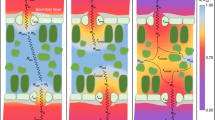Abstract
A system for measurement of leaf gas exchange while regulating leaf to air vapour pressure difference has been developed; it comprises an assimilation chamber, leaf temperature controller, mass flow controller, dew point controller and personal computer. A relative humidity sensor and air and leaf temperature sensors, which are all used for regulating the vapour pressure difference, are mounted into the chamber. During the experiments, the computer continuously monitored the photosynthetic parameters and measurement conditions, so that accurate and intenstive measurements could be made.
When measuring the light-response curve of CO2 assimilation for single leaves, in order to regulate the vapour pressure difference, the leaf temperature and relative humidity in the chamber were separately and simultaneously controlled by changing the air temperature around the leaf and varying the air flow rate through the chamber, respectively. When the vapour pressure difference was regulated, net CO2 assimilation, transpiration and leaf conductance for leaves of rice plant increased at high quantum flux density as compared with those values obtained when it was not regulated.
When measuring the temperature-response curve of CO2 assimilation, the regulation of vapour pressure difference was manipulated by the feed-forward control of the dew point temperature in the inlet air stream. As the vapour pressure difference was regulated at 12 mbar, the maximum rate of and the optimum temperature for CO2 assimilation in rice leaves increased 5 μmolCO2 m−2 s−1 and 5°C, respectively, as compared with those values obtained when the vapour pressure difference took its own course. This was reasoned to be due to the increase in leaf conductance and the decrease in transpiration rate. In addition, these results confirmed that stomatal conductance essentially increases with increasing leaf temperature under constant vapour pressure difference conditions, in other words, when the influence of the vapour pressure difference is removed.
This system may be used successfully to measure inter- and intra-specific differences and characteristics of leaf gas exchange in plants with a high degree of accuracy.
Similar content being viewed by others
Abbreviations
- A:
-
CO2 assimilation rate
- Amax :
-
Maximum rate of CO2 assimilation
- Aopt :
-
Optimum teperature for CO2 assimilation
- CTWB:
-
Controlled-temperature water bath
- DPC:
-
Dew point controller
- E:
-
Transpiration rate; gl, leaf conductance
- HCC:
-
Humidity control circuit
- IRGA:
-
Infrared gas analyzer
- LT:
-
Leaf temperature
- LTC:
-
Leaf temperature controller
- MFC:
-
Mass flow controller
- QFD:
-
Quantum flux density
- RH:
-
Relative humidity
- RHC:
-
Relative humidity controller
- VPD:
-
Vapour pressure difference
- ΔCO2 :
-
Difference of CO2 concentration between inlet and outlet air
References
Gaastra P (1959) Photosynthesis of crop plants as influenced by light, carbon dioxide, temperature and stomatal diffusion resistance. Meded LandHoogesch, Wageningen 59: 1–68
Hall AE and Kaufman MR (1975) Stomatal response to environment with Sesamum indicum L. Plant Physiol 55: 455–59
Hall AE, Camacho-B SE and Kaufman MR (1975) Regulation of water loss by citrus leaves. Physiol Plant 33: 62–65
Jarvis PG and Mansfield TA (1981) Stomatal Physiology. Cambridge University Press, Cambridge
Kanda A, Imai K, Moriya T, Handa S and Terajima T (1984) A gas exchange measurement system and its application to rice and cassava leaves. Japan Jour Crop Sci 53: 472–478
Koch W, Lange OL and Schulze E-D (1971) Ecophysiological investigations on wild and cultivated plant in the negev desert. I. Methods: A mobile laboratory for measuring carbon dioxide and water vapour exchange. Oecologia 8: 296–309
Lösch R (1979) Responses of stomata to environmental factors. Experiments with isolated epidermal strips of Polypodium vulgare. II. Leaf bulk water potential, air humidity, and temperature. Oecologia 39: 229–238
Schulze E-D (1972) A new type of climatized gas exchange chamber for net photosynthesis and transpiration measurements in the field. Oecologia 10: 243–251
Schulze E-D and Hall AE (1982) Stomatal responses, water loss and CO2 assimilation rates of plants in contrasting environments. In: Lange OL et al. eds. Physiological plant ecology II, pp 181–230. Encyclopedia of plant physiology. New Series, Volume 12B, Springer, Berlin
Sestak Z, Čatsky J and Jarvis PG (eds) (1971) Plant photosynthetic production: Manual of methods. The Hague: Dr W Junk Publishers
Turner NC, Schulze E-D and Gollan T (1984) The responses of stomata and leaf gas exchange to vapour pressure deficits and soil water content. I. Species comparisons at high soil water contents. Oecologia 63: 338–342
von Caemmerer S and Farquhar GD (1981) Some relationships between the biochemistry of photosynthesis and the gas exchange of leaves. Planta 153: 376–387
Author information
Authors and Affiliations
Rights and permissions
About this article
Cite this article
Agata, W., Kawamitsu, Y., Hakoyama, S. et al. A system for measuring leaf gas exchange based on regulating vapour pressure difference. Photosynth Res 9, 345–357 (1986). https://doi.org/10.1007/BF00029799
Received:
Revised:
Issue Date:
DOI: https://doi.org/10.1007/BF00029799



